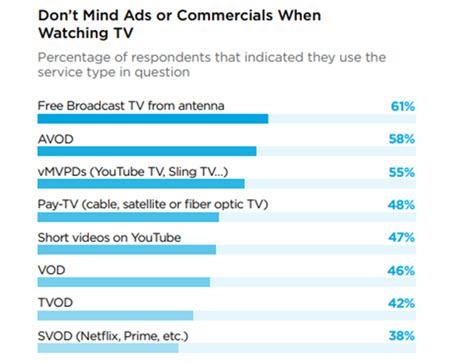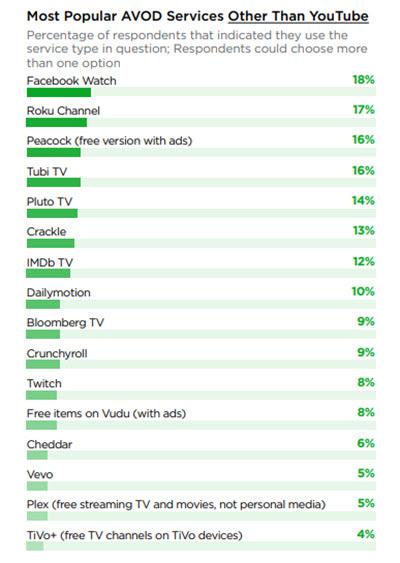Consumers in the U.S. and Canada are now spending an average of $112.10 per month on pay-TV bundles (including internet service), and $31.80 per month on subscription video-on-demand/SVOD,
according to TiVo’s Video Trends Report Q2 2021.
For most people, those are significant amounts.
In fact, the survey of 4,500 North Americans ages 18 or older found 55% saying
that they’re spending too much for video entertainment.
That makes cost the third most-cited video pain point, after the difficulty of finding good shows and movies to watch (60%) and
figuring out which service has everything they want (59%).
So it’s hardly surprising that consumers who watch free content continue to express the most tolerance for ads being part of
the TV viewing experience.
Nearly two-thirds (61%) of those who watch free broadcast via an antenna, and 58% of those who watch ad-supported video-on-demand/AVOD say they “don’t
mind ads or commercials while watching TV.”
advertisement
advertisement
What’s more interesting is that more than half (55%) of those who watch paid virtual MVPDs like YouTube TV and Sling TV, and nearly half
(48%) of those who watch pay-TV (cable, satellite or fiber optic) and video-on-demand say they don’t mind ads while watching TV.
Perhaps even more notable: Among those who pay for SVOD
services or transactional video-on-demand/TVOD, 38% and 42%, respectively, say they don’t mind ads while watching TV.

Some of this is a bit fuzzy, since many of the respondents no doubt
use more than one type of service, including both free and paid services. So were some who used both free and paid services thinking only of their free or limited-ads, cheaper-than-premium SVOD
experiences when they said they’re OK with ads during TV viewing? Probably.
Still, even if we build in some leeway, it seems a positive indicator for advertisers that roughly 40% to 55%
of consumers who pay for video/TV content are OK with ads during TV viewing.
Further, 81% say they’d rather use free, ad-supported streaming than subscribe to another paid service, and
83% say they wish that paid streaming services like Netflix or Prime Video offered a free, ad-supported option.
Screen and device type may play a role in consumer attitudes about ads: 31% say
that ads on a smartphone or tablet are worse than ads on a TV, and 23% say that TV ads are worse—although 38% say they’re the same.
“For those with cost concerns — the
vast majority of consumers — free, ad-supported video services are increasingly seen as solid alternatives — allowing them to access content without adding to their total entertainment
bill,” sums up the report.
Asked about their preferred type of AVOD experience, 39% reported wanting a free service that offers live TV channels in a guide, and 47% said they prefer a
free service that offers an on-demand library of TV shows and movies.
While not actual market share percentages, the survey results also seem to indicate that the race among AVOD services is
fairly neck-and-neck.
Asked which AVODs they watch (excluding YouTube), Facebook Watch was cited by the largest percentage of these respondents: 18%.
But the Roku Channel, Peacock
(which came in third after little more than a year in operation) and Tubi TV are just one to two percentage points behind. And Pluto TV, Crackle and iMDb TV also follow closely.
In fact, the
spread between the No. 1 and No. 5 AVODs is just four percentage points, and the spread between No. 1 and No. 10 is just eight points.
